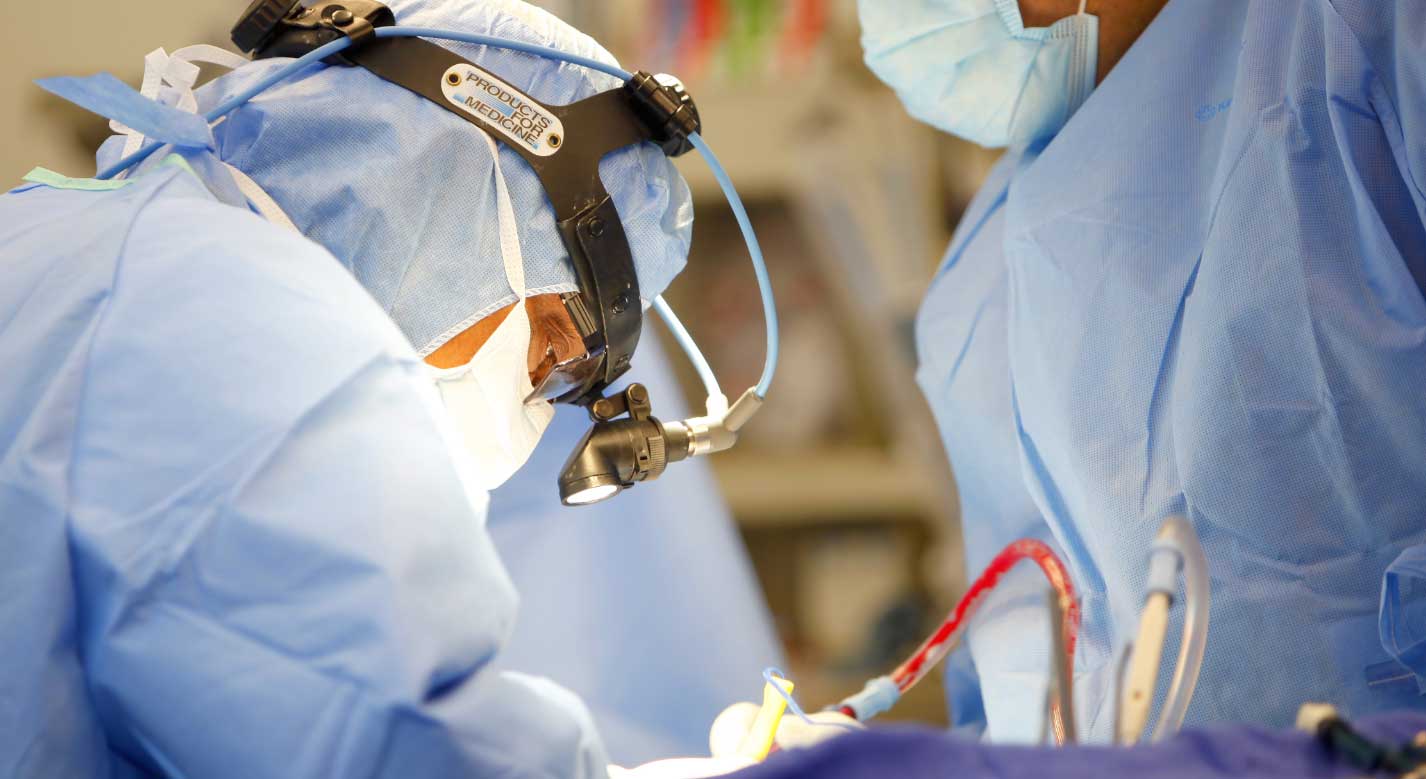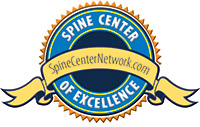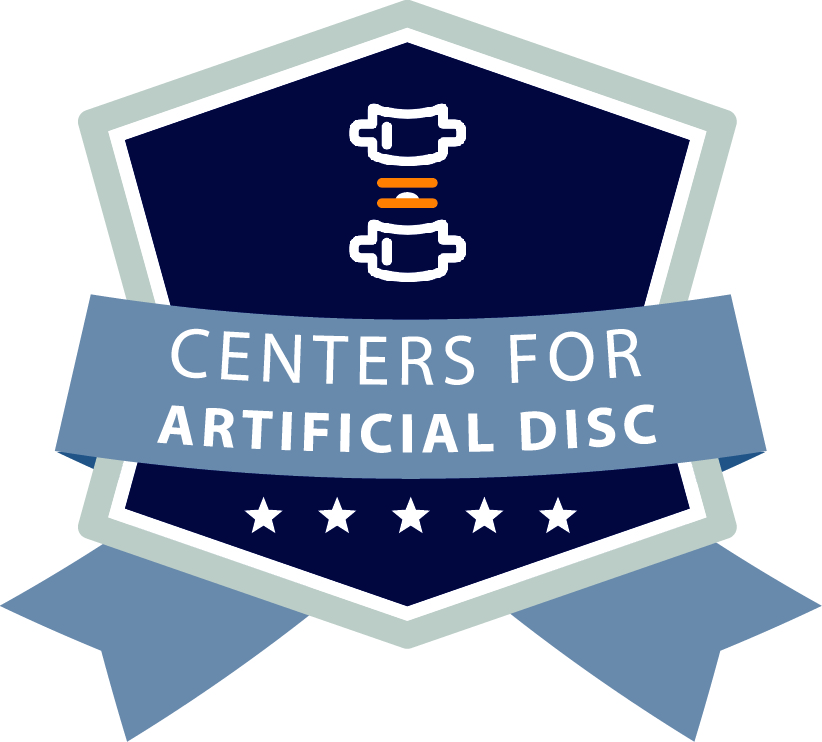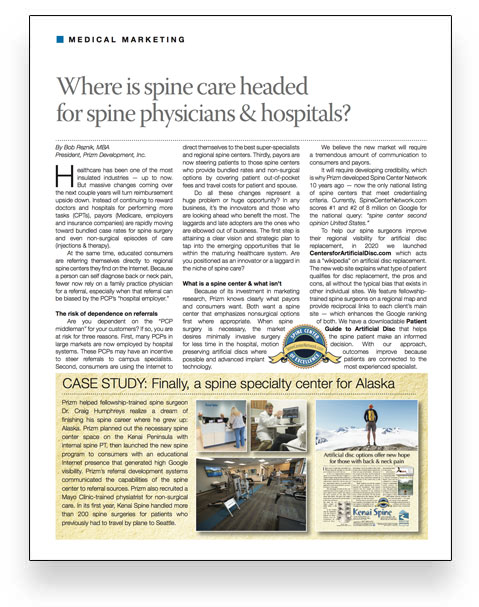Celebrating 30 years as the nation’s most experienced developer of spine & orthopedic centers of excellence.
- 817-481-2450
- Contact Us
-
Spine Center Development
How to Launch a Spine Center

Do you have 20/20 vision for year 2020?
Or is your spine center a vision for the rear view mirror?
by Bob Reznik, MBA
President, Prizm Development, Inc.
Celebrating 25 years developing Centers of Excellence for Better Healthcare
Thinking about developing a spine center? We see hospitals and specialty groups launching programs that are as modern and timely as a horse and buggy is to travel. We see some spine programs as merely glorified surgical mills or injection shops set up as a marketing mousetrap to capture patients for a slip-and-slide toward diagnostics and procedures … the traditional fee-for-service strategy of more CPTs (tasks) begets higher revenues.
In other cases, some spine centers may have assembled the correct, necessary ingredients, but the providers — spine surgeons, physical medicine physicians and spine therapiists — are segregated into different treatment areas (or even different floors) so there is no communication let along collaboration.
Instead the back and neck patient is punted down an assembly line of providers, diagnostic tests and procedures until they reach the surgical suite which appears to be the end goal of some programs. For the back and neck patient it can be frustrating having to repeat oneself to the next provider on the assembly line. The back or neck pain patient wonders, “Hey this is all one building, don’t these people talk to each other?”
In other cases, a hospital politically tries to INCLUDE every possible specialty into a “center of excellence” that by definition is EXCLUSIONARY. In our 25 years of business as spine center developer, I’ve traveled by plane to then walk into a large conference room meeting featuring every tangential spine provider in the institution: neurologists, radiologists, anesthesiologists, good surgeons, bad surgeons, chiropractors, et al. They are there, ostensibly, because the Ark is being designed in advance of the coming competitive storm, and they want a seat on it.
But isn’t “including everything and everybody” the real problem with spine care? According to payors it is. They’ve told us so. For them, less is more. They want less fragmentation. They want less CPTs. They want fewer and smaller bills. They see “more” as the problem with spine care.
If a hospital can get past the “include everybody” obstacle, they have a chance. But there are still several other chuck holes down the road.
What is the goal of your spine center?
It’s understandable in that a spine surgeon may want more spine surgeries, as that is the most lucrative aspect of spine care, at least for now. Also understandable and logical that a hospital CEO sees spine as one of the last specialties to leave the domain of the hospital inpatient bed. Understandable they then hire a new orthopedic or neuroscience service line director to build the coveted spine program and install the spine center sign on campus. Turn on the tractor beam.
But reimbursement is now chipping away at that. So are health insurance companies and large employers who are steering back and neck pain patients to regional multi-disciplinary and minimally invasive spine centers that can do spine surgery through tubular retractors at an ASC so the patient can go home later the same day.
So how do you launch a spine center geared to today’s rapidly changing market for spine care? Skip the horse and buggy, or high profit gas guzzler, and think self-driving electric car with a battery that charges fast.
Launching a spine center for Year 2020 requires clear 20/20 vision for where spine care is headed. And this means having a clear understanding of what the customer wants — rather than what the hospital, health system, or spine surgeon may want of the spine center venture.
Developing a successful spine center also requires aiming ahead, much like a hunter leads the deer running along the horizon with the sights on his rifle. It requires you to develop a spine program that is geared to the future of spine care rather than the past.
In our 25 years of experience, spine surgeons are typically highly intelligent who were at the top of their class. So when you explain the logic of HOW something works best, and WHY something needs to be done, their Intel logic chip processes data rapidly. If you explain that you can attract complex spine cases by setting up nonsurgical spine care components with a “heart center model,” they get it and are quickly “all-in.” They are okay with shutting the back door of the Ark and moving it out to sea, the faster the better.
Who is the customer?
Who is the customer for the spine center? Is it the spine surgeon? Based on what we sometimes see being developed, one would think so.
When we say “customer” we mean the large employers and health insurance companies that pay the high price for spine surgery and an ongoing pain management if that spine surgery doesn’t work out as planned.
We also mean the people with back or neck pain who are educating themselves about minimally invasive spine surgery, and what works and what doesn’t. The more educated the consumer, the more they will learn that they should exhaust non-surgical treatment options before surgery.
And their insurance company or employer may now prevent them from making a bad choice, because the payor tired of paying bills over $100k for a spine surgery that doesn’t work.
What has caused this sea change in specialty care and spine center development?
Let’s look at the trends. In Alaska, some payors are now putting back and neck pain patients and their spouses on a plane — in first class seats — to fly them down to Seattle for assessment at a multidisciplinary spine center rather than let them get the spinal fusion (they were told they needed) back in Anchorage. From the payor’s experience, that traditional spinal fusion may or may not go well, with some percentage of spine patients ultimately falling through the trap door of “failed back surgery syndrome” and requiring years of ongoing pain management or a spinal cord stimulator.
When this back patient arrrives in Seattle at this future-oriented spine center, a spine surgeon isn’t the one to assess them. Nope. Hang onto your hat. A physical medicine MD and a spine therapist assess the patient and decide if that spinal fusion can be delayed or avoided with spinal injections or spine therapy. But if all that fails, and surgery is necessary, that same spine center will provide the minimally invasive spine surgery — under a predictable bundled rate.
In the lower 48, Walmart is likewise now steering spine patients into regional spine centers that emphasize NON-surgical spine care with PM&R physicians managing a large part of the spine care episode of care — often at a predictable bundled price for an episode of care. Ditto cancer and other expensive specialties that likewise are often mismanaged.
Blue Cross has created Blue Distinction Centers and now require their spine patients to go to one of these “credentialed spine centers of excellence” if they want coverage. Cigna and Aetna are right behind in their similar efforts.
Priority Health in Michigan authored an article in Spine Journal about their spine center of excellence model that required all back and neck pain patients to start off with a PM&R evaluation before they could even be seen by a spine surgeon. That model reduced spine surgeries 25% in that state, and has since been widely copied by other carriers in other states.
Having directed the development of the first, largest, and still one of the most prominent spine centers in the world, back in 1986 for its first nine years, I have been asked to speak at dozens of spine center development seminars. In these presentations physicians and hospitals want to know what ingredients to put in their spine center launch so it’s successful and able to ultimately be perceived as a regional spine center of excellence by consumers, health insurance companies and large employers.
I watch them studiously making their lists like scribbling down the ingredients for the perfect cocktail ….
• Fellowship-trained minimally invasive spine surgeons, ortho & neuro
• Fellowship-trained Physical Medicine & Rehabilitation physicians for spinal injections and evaluation and management
• Spine specialized therapists with advanced training and certification in skill sets like McKenzie, Paris, Cyrian, Grimsby, Maitland, etc.
The trap doors to failure
With all that — including all the correct ingredients and correctly excluding the wrong ones — so much still can go wrong.
A common problem we see when we are brought in to fix a spine program that hasn’t thrived, or is perceived to be simply more of the problem rather than part of the solution, can relate to a flawed space plans. Docs love to create space plans. They have strong ideas for how they’ve practiced medicine in their previous office, or in their training. So when given an opportunity, here comes the Edsel.
The most common trap door to failure with spine center space planning is what we call “The Captain of the Ship” space plan.
This has origins in how general orthopedic surgeons often practice, with four exam rooms in a pod. A physician assistant (their first mate) tees up the patient in one room while the orthopod assesses the new patient in another. During the course of a day, the first time that surgeon sees a non-surgeon MD might be in the parking lot as they head home.
The cardiologist/cardiovascular surgeon heart center model
But spine care has little in common with knees, ankles or shoulders.
Prizm bases its spine center development on more than 500 one-on-one meetings with medical directors at large health insurance companies, work comp carriers and risk/benefit VPs at large employers around the country. No one has listened to more payors and employers barf about dysfunctional spine care than Prizm.
Consequently, for the 25 years we’ve been in business, we’ve developed spine centers that are based on the heart center model. Just as a cardiologist manages all the nonsurgical treatment options for heart disease (keeping LDL levels low, HDL levels high, managing exercise, diet, BP, etc) and if necessary, something more invasive like inserting a stent. Heart rehab does its role as well. If all that fails, it’s time for the cardio-thoracic surgeon to do what they do best. Tight communication not fragmentation.
We also learned that payors don’t like surprises and unpredicability. So for more than 20 years, we’ve set up predictable bundled prices for not only surgeries, but also bundled prices for non-surgical episodes of care for back and neck pain.
Ironincally, if you do EVERYTHING right, and set the spine center up correctly, a regional spine center WILL attract complex spine patients from a wide geographic area, which will in turn keep the spine surgeon busy doing what they know how to do, and the hospital filled where appropriate. Voila — the end goal through a different route. Intead of a mill or marketing mousetrap, it’s a better way of spine care.
Spine center development, when done correctly, is a win-win-win — with the last win being the educated back or neck pain patient who exhausts non-surgical treatment options first. If necessary he or she then receives the most advanced minimally invasive surgical spine care. And afterward, that same patient has been evangelized to preventing a future strain or herniated disc.
Isn’t that the kind of spine center that you would recommend to your own mom or friend if they had symptoms of radicular pain into a leg or arm?
The trick, in our 25 years of experience, is more difficult than assembling a list of docs, shoving them into their favorite space plan, and getting the sign company to install the lighted letters on monument sign saying “spine center.” Ultimately, over time, with the future in the windshield, the parking lot may end up empty.
Disclaimer:
The pictures displayed in this website are images of physicians, patients and employees who have consented to have their pictures in this website. If you are viewing in Internet Explorer 8 or older you may need to update your browser.
RELATED TOPICS
Spine Center Development How to Launch a Spine Center Market Assessment Spine Center Design Space Planning Name Development Medical Advice Exercise Library Patient Education Case Rate Pricing ASCs & Specialty HospitalsHAVE A QUESTION?

Wouldn’t it be convenient if someone created a listing of spine centers of excellence across the United States that all emphasize non-surgical treatment options before surgery?
Finally, there is a place.

Centers for Artificial Disc is the only verified national listing of spine centers that specialize in artificial disc replacement surgery.
CentersForArtificialDisc.com